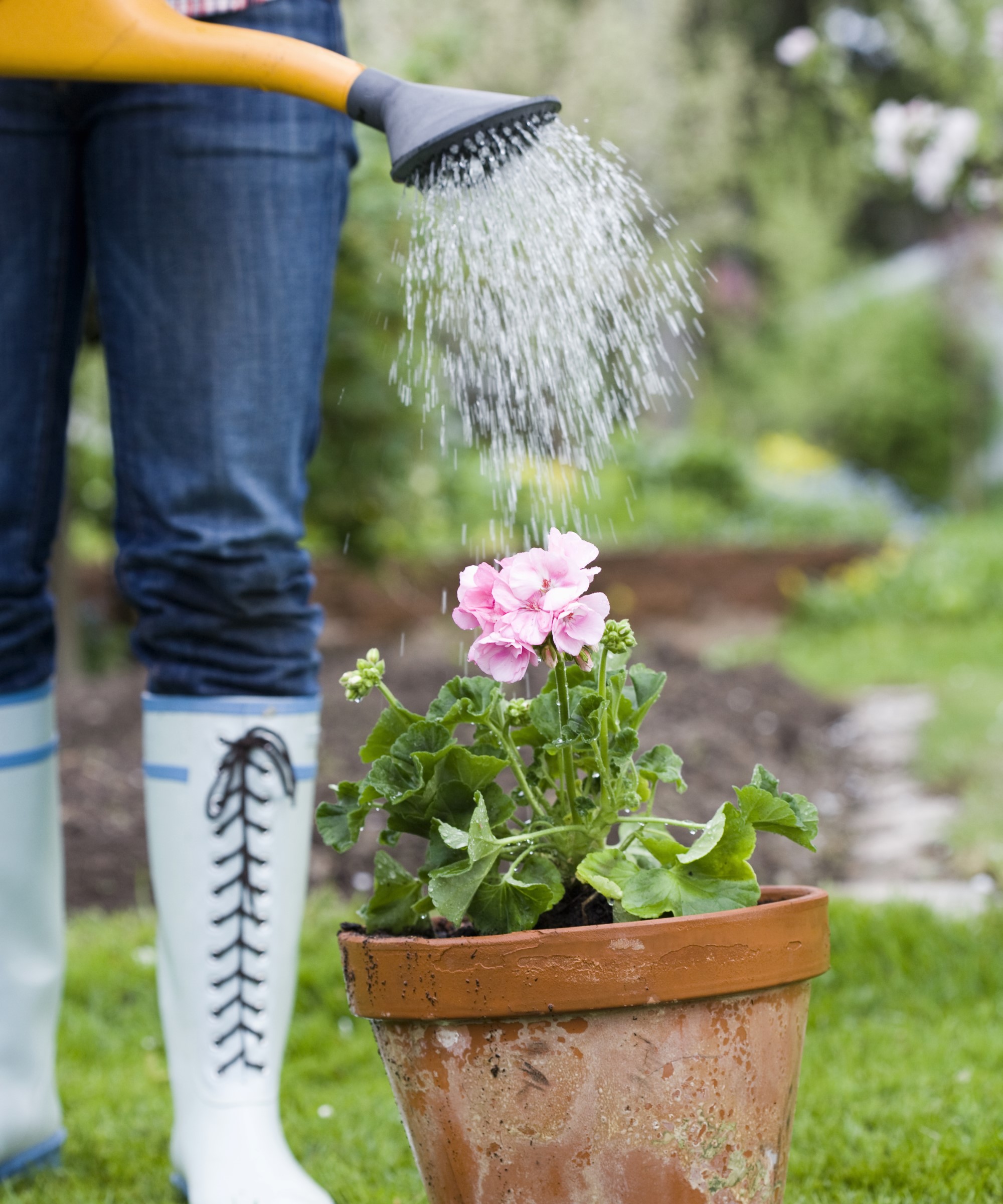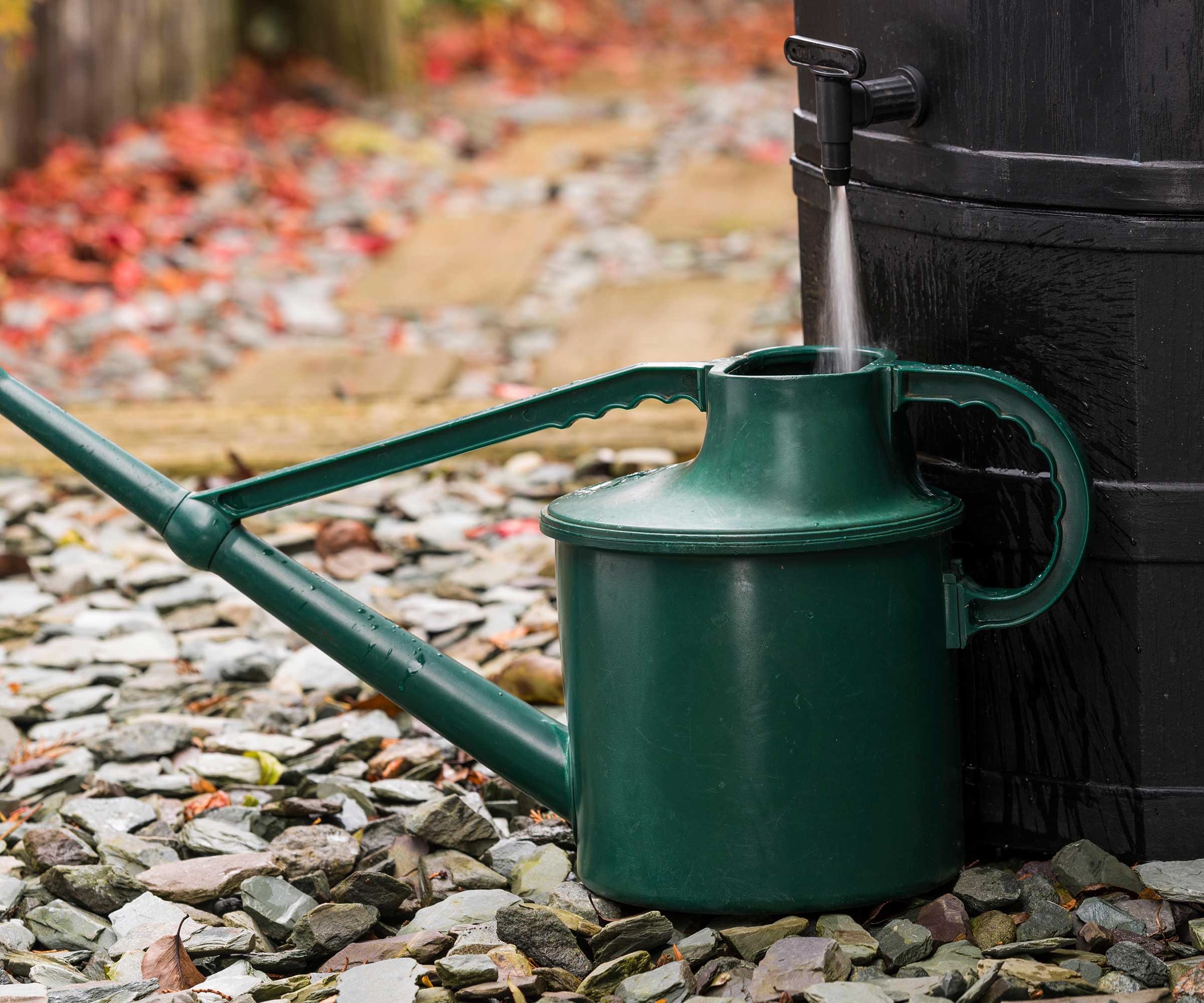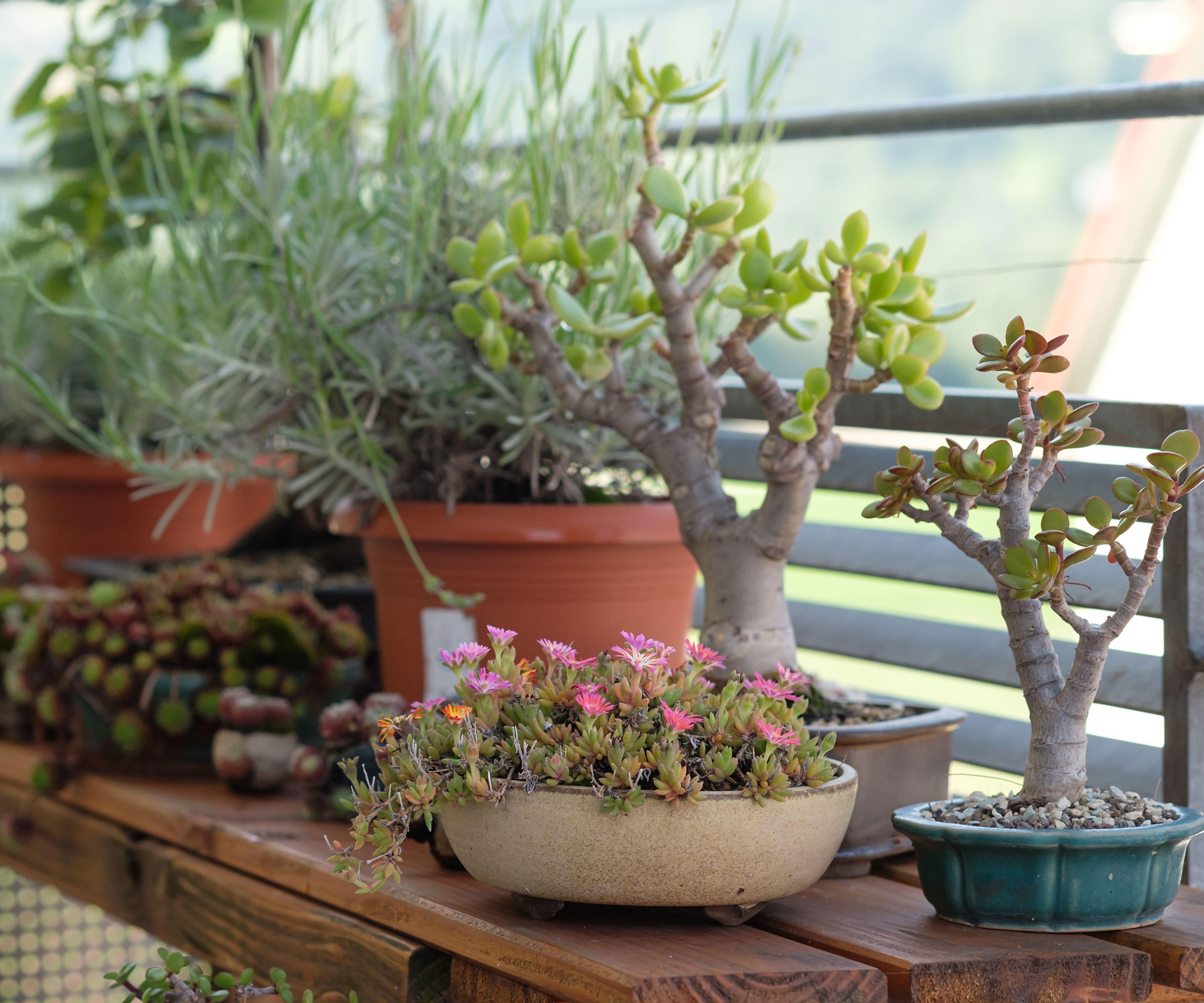10 essential tips from a professional gardener for watering plants in containers correctly
Keep any plants in pots happy by following these dos and don'ts


Watering can be a tricky art to master for container gardens as it does not take long for a plant to go from looking healthy to wilting. That fine line also comes into play between soil being too dry and too wet, with both potentially harmful to your plants.
When thinking up container gardening ideas you want to ensure the plants are going to look their best and put on a fantastic display. A great display needs healthy and thriving plants, which is going to mean keeping on top of watering. The choice of pot and the location of the container both play their part, as does the gardener paying very close attention and watering correctly.
I gained a lot of experience when it comes to watering pots during my time as a professional gardener. I was tasked with maintaining the pot displays at Hidcote Manor Garden in the UK during my time there. This required thorough and regular monitoring of moisture levels in more than 100 containers and planters in the famous arts-and-crafts garden. I looked after plants in containers in all the historic gardens I worked in, and there is also a large collection of potted plants in my own garden.

A wealth of plants can be grown in pots in a backyard
10 key tips for watering plants in containers
Many new gardeners are taken aback by how much watering is required with container gardening. The truth is that the soil dries out a lot quicker in containers than in beds and borders. This is down to the minimal amount of soil in the pot to hold moisture and release it to the plants. Failing to water plants properly is one of the biggest and most common container gardening mistakes. Plants are commonly either underwatered and overwatered, and both can have devastating consequences.
We look at 10 key pointers that can help you become a master when it comes to watering your container garden.

Watering plants in containers requires care and attention
1. Consider the container

Terracotta containers dry out quicker than other materials
The limited amount of soil in the pot causes it to dry out quickly, so the logic works that the smaller the pot the quicker it dries out. That means more frequent watering for smaller pots and an increased need to be really meticulous when it comes to checking moisture levels in the soil.
By opting for larger containers it means there is more soil to be able to hold the moisture. However, do not pick an oversized pot or planter box for the sake of it as a container that is too large can slow the growth of a plant. Take into consideration the expected final size of the plant when picking pot size.
Design expertise in your inbox – from inspiring decorating ideas and beautiful celebrity homes to practical gardening advice and shopping round-ups.
As well as the size of the pot, the material can play a part in how often you have to water. Terracotta containers are known for drying out quicker than other materials. While they may look better than their plastic counterparts and help create a Mediterranean garden feel, they can lead to more trips with watering cans than if you had your plants in plastic or glazed pots. Metal containers can also dry out quickly as the soil quickly heats up thanks to the summer rays.
2. Think about drainage

Lots of pots or containers will come with holes in the bottom
One of the most essential factors of growing any plants for pots, and one that will have an undoubted impact on plant health and any watering, is drainage. Proper drainage is key to healthy plants. Most plants don’t want to sit in soggy soil and a build-up of moisture in the pot will suffocate plant roots.
When it comes to what to put in a planter for drainage, the number one thing is drainage holes. These small, yet vitally important, holes will allow excess water to drain out of the pot and not pool at the bottom. Drainage holes also help when it comes to watering plants as you can monitor when water is coming out of the pots. It is also important to raise pots on small feet, such as these Solid Rubber Pots Risers available at Amazon, to allow the water to freely flow and for the holes to not get clogged.
3. Check soil further down

Check moisture levels below the surface before watering
Looks can be deceiving in many facets of life, and that includes identifying when to water plants. This is where it is handy to check moisture levels more than just by eye. Sticking your finger into the soil allows you to discover what the moisture levels are a few inches down in the container.
It is very common for the pots to look dry at the surface but actually still be moist below, or for the soil to look moist when in reality it is damp on the surface but dry further down – and that top moisture can quickly evaporate away.
By sticking your finger into the soil you can feel what the moisture is where the eyes cannot see, and then make a better and more educated call on whether the pot needs watering or not.
4. Water thoroughly

A good soak will benefit the plant more than a light watering
When you are watering plants in containers, you want to make sure that the plant is getting a thorough drink that will sustain it. Therefore it is important to water the pot thoroughly and ensure to moisten all the compost in the pot. A flimsy water of just the soil at the top will not encourage plant roots to venture down into the pot and take advantage of the nutrients and moisture in the soil deeper down. Shallow roots near the surface are then more likely to succumb to any drought or heat. Consider whether it is better to water the plants from the top or the bottom, as smaller pots could benefit from being sat in a container of water to soak up the water from below.
Ensure to saturate all the soil in the pot, not only will the plants thank you but it will extend the amount of time until you have to water again. So, whether you are using a hose or a watering can, water the pot slowly and fill it until you see water coming out of the drainage holes.
One good method for how to water plants is to fill the container until the water almost flows over the rim and then wait to allow the moisture to absorb into the compost. Top up with extra water a second time if required.
5. Pick the right time of day

Mornings are the ideal time to water plants in containers
The best practice for watering plants in hot weather, whether they are patio plants in pots or in the ground, is to not water in the heat of the day. Watering in full sun is a common garden watering mistake and means a lot of the moisture will evaporate before the plants can benefit from it, and there are fears that any water on the foliage can potentially burn the plants.
The best time to water plants in pots is in the morning, as it gives the plants lots of time to take in the moisture before the heat of the day and evaporation occurs. Plants can be watered in the late evening when the temperatures are also cooler, however, that does come with increased risks as any water that gets on the foliage will not dry out and increase the potential risk of fungal diseases.
6. Get water where it’s needed

Don't water the foliage from above, water the soil instead
When you water plants, you want that water to target the part of the plant that needs it most. As plants absorb water through their roots, you want to focus on watering the soil rather than watering the foliage. Targeting the soil means all of the moisture is going to the precise area where the roots need it and can access it.
There are even vegetable garden hacks that can be utilized in containers, such as burying pots or bottles to further focus the water down to the level of the plant’s roots. One example of this is using these types of Slow Release Plant Watering Spikes designed for bottles, available at Amazon.
A further potential issue of simply watering the plant from above is that wet foliage as a result can again encourage fungal problems and even scorch leaves in the heat of the day.
7. Rain might not suffice

Rain might not penetrate the foliage and make it down into the soil
Never assume that any rain will have sufficiently watered your pots. Even after rainfall, it is best practice to check pots for watering as normal. While in an ideal world a shower would perfectly hydrate plants and do the job of watering for you, you cannot absolutely rely on any rain.
There are a few reasons for this, and one is that pots can often sit in a rain shadow next to fences or buildings where they don’t get as much rainfall due to the obstruction. A rain shadow is also important in where to place a raised bed, as placing them too close to walls or fences means they miss out on rainwater.
A plant’s foliage can also prevent water from getting to the soil, essentially acting like an umbrella that diverts water away from the pot and not allowing rainwater to reach the soil where it is needed.
By making a rain barrel to harvest rainwater, you can capture as much water as possible, and then use it for watering your plants.
8. Check levels regularly

In summer you may need to water plants in containers multiple times a day
Regular monitoring is important to keep on top of watering. This is especially critical during the summer, where there can be prolonged periods of hot and dry weather. At this time you need to check pots daily, however, there may also be times when the pots need watering twice a day.
As mentioned earlier, some pots dry out quicker than others and that will be increasingly problematic during hot summer days. A morning water may not be enough to sustain them for long, especially with smaller pots, and they will potentially require a second water later in the day. This may be easier if you have a small garden or small patio, but remains an essential task nonetheless.
9. Know your plants

Succulents in containers will require less watering than other plants
Watering is not a one-size-fits-all solution, many different plants have varying conditions that they thrive in. That is where it pays to know your plants and what moisture levels they like. Most garden plants want moist soil that drains well, so it retains water available to their roots but also flushes away excess moisture efficiently to stop plants from sitting in soggy soil.
While some plants want to be constantly moist, such as vegetables, you also get popular rock garden plants such as alpines or succulents that are common in pots and prefer drier conditions. Herb planters may too want to be kept on the drier side.
It is all about doing your research to understand your plants and what levels of moisture they want and how they might react, as some plants simply cannot tolerate drying out while others are more amenable.
Some plants do require a bit of extra knowledge, for example, when growing citrus trees in containers it is recommended to let the soil dry out and then flush the pot thoroughly with lots of water.
10. Take advantage of watering tools

Self-watering plants can be beneficial and take some off the pressure off
There are useful tools around to provide assistance for watering plants in containers. Some are more basic than others, such as placing a saucer underneath pots to catch excess water and keep it available to the plant if and when required.
You can also get water-retentive gels or granules that can be added to the compost. These materials absorb a large amount of water and retain it in the pot. Such water-retaining materials, for example, the Miracle-Gro Water Storing Crystals available at Amazon, can help reduce the amount of watering required during dry spells but does not remove the need to regularly check pots.
You can also get automated watering systems and self-watering planters – an example of which is this 16" Oval Self Watering Planter available at Amazon – that can help remove some of the burden of watering. They can be particularly useful for watering plants when you're away on vacation too.
FAQs
How often do you water new container plants?
Plants will need regular watering to get them established in a new container. Any new additions to a container garden will have higher watering demands than established plants. The exact amount will depend on the plant, the location, the pot size, and the daily weather, but, on a warm summer day, they will need watering once a day at a minimum. Check the pots regularly to keep the soil moist and water the pot slowly and deeply each time. This will ensure the plant develops strong roots in the container.
Can you overwater potted plants?
You can overwater outdoor plants in pots, and indoor potted plants, and overwatering can be as problematic as underwatering. An overwatered plant can show signs of stress such as wilting, yellow leaves, leaf drop, and stunted growth. There may also be moss or algae growing on the surface of soil that has been sitting sodden. It is possible to fix an overwatered plant, though the use of a soil moisture meter to show you the moisture levels in the soil can help prevent the situation from getting that far.
Should I water pots every day?
Pots will need watering daily if the temperatures are high, and it is important to remember that strong winds can also dry out the soil in pots. When temperatures peak it may take one or two bouts of watering a day to keep the soil moist in summer. During the warmer months, it is recommended to check the moisture levels in pots daily to avoid the soil drying out.
Watering plants in containers need not be a mystery if you listen to these 10 helpful pointers. A lot of it is simply down to giving your plants good care and attention.
Whether you have a vegetable container garden or are growing ornamental flowers in pots, make sure to put watering at the top of your priority list.

Drew has worked as a writer since 2008 and was also a professional gardener for many years. As a trained horticulturist, he worked in prestigious historic gardens, including Hanbury Hall and the world-famous Hidcote Manor Garden. He also spent time as a specialist kitchen gardener at Soho Farmhouse and Netherby Hall, where he grew vegetables, fruit, herbs, and cut flowers for restaurants. Drew has written for numerous print and online publications and is an allotment holder and garden blogger. He is shortlisted for the Digital Gardening Writer of the Year at the 2025 Garden Media Guild Awards.


